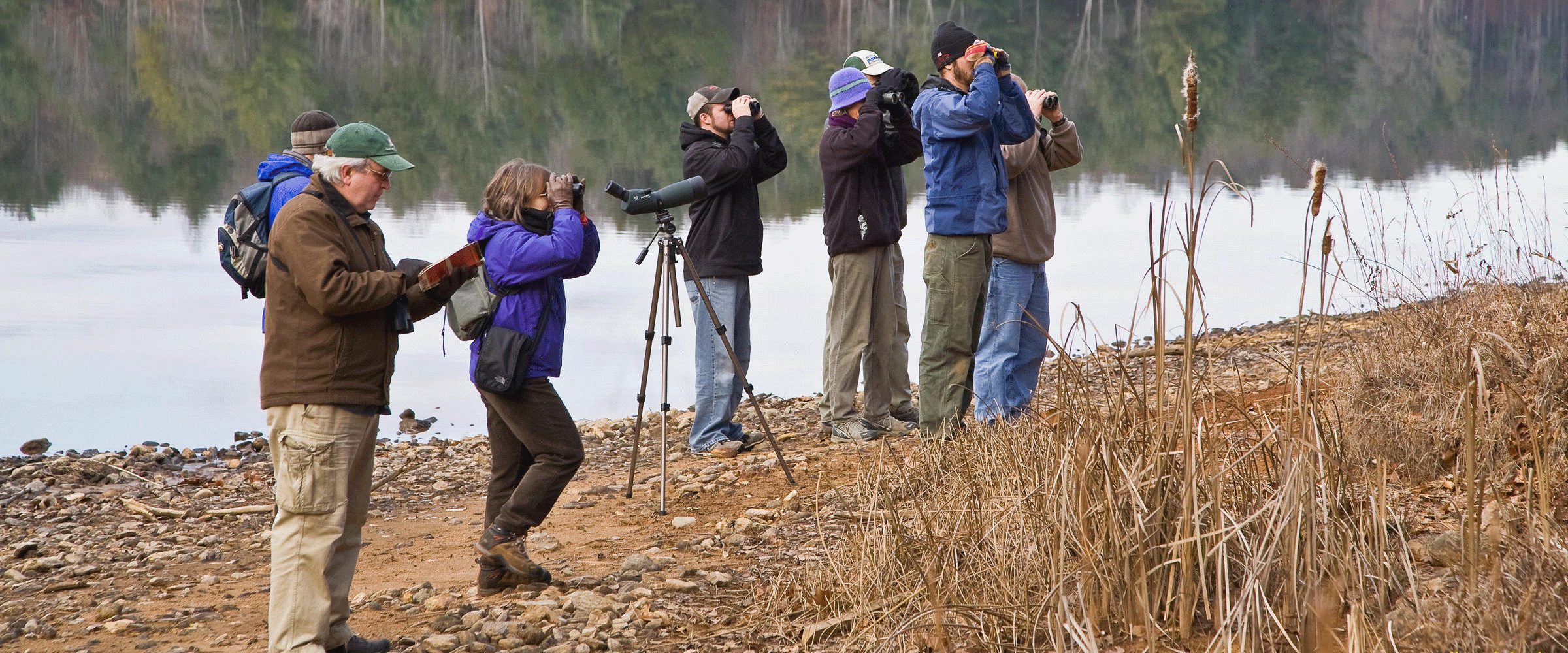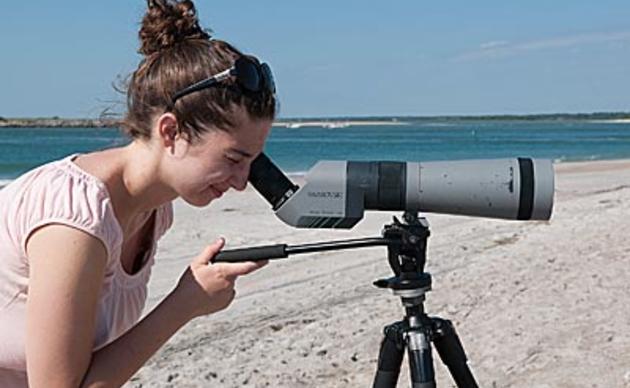Birding and Birdwatching Basics
Bird watching is a great way to connect with nature and enjoy the outdoors, and North Carolina provides wonderful opportunities to see a variety of species, from charming backyard birds like the Carolina Chickadee and Northern Cardinal to mountain migrants like the Golden-winged Warbler and coastal species like the Brown Pelican. According to the U.S. Fish and Wildlife Service, about 50 million Americans are bird watchers, and bird watching contributed about $36 billion to the economy in 2006. If you want to join a group of friendly birders, consider joining an Audubon Chapter.
One reason bird watching is so popular is that birds are everywhere, and anyone can find and observe them. Their beautiful plumage, varied and intricate behavior, and seasonal migrations make birds fascinating to study. To get started with bird watching, all you need to do is look out your window. To learn more, such as how to use a field guide, select binoculars and identify birds, visit How to Begin Birding and explore the links below.
North Carolina Bird List – What species might you see in North Carolina? There have been 473 species recorded in the state, and this list will show you which ones you might encounter.
North Carolina Birding Trail – Not sure where to go to watch birds? The North Carolina Birding Trail is a network of 311 sites divided by region—mountain, piedmont and coastal plain—for which directions, species and other information is provided.
Carolina Bird Club – The Carolina Bird Club organizes field trips, publishes The Chat, a quarterly journal for ornithology in the Carolinas, and maintains a listserv for bird sightings.
eBird – eBird allows birdwatchers to report their sightings online to scientists who will use the data to study bird distribution, movements and abundance trends. It’s also a great place to electronically store your bird lists.
North Carolina Bird Atlas – The NC Bird Atlas is a statewide community science project to map birds during the breeding and wintering seasons. They support participation by a diversity of humans for the diversity of birds.
Carolina Young Birders Club – The Carolina Young Birders Club strives to connect like-minded kids and teens throughout both North and South Carolina. They also offer scholarships to support young birders in their passion for ornithology.
North Carolina Birding Destinations
With North Carolina’s emphasis on preserving the beauty of nature, there is always another birding destination to discover! And most are located just beyond your own neighborhood. The NC Birding Trail is a fantastic resource for bird nerds to track down your warblers, eagles, terns and more.
Did you know more than 300 stops along the Birding Trail intersect with an Important Bird Area (IBA) in North Carolina?
With 96 IBAs supporting birds throughout NC, it is important to remember that some locations are important for birds and therefore need to be closed to people at certain times of the year. Here you will find areas with full access for people to connect with birds in their habitat.
In the Piedmont
- The Pilot Mountain IBA sits just 21 miles north of Winston-Salem and can be accessed from the Pilot Mountain State Park. This IBA is a key corridor for migrating raptors and also attracts birds typically seen in higher elevations due to the mountains close by.
- Residents of Bull City are no strangers to the Eno River Bottomlands IBA. Set just 10 miles from Durham, this habitat spanning 12,000 acres is lined with hiking trails to get your birding adventure off to a great start in the piedmont.
- Jordan Lake, located 20 miles outside of Raleigh, is a birders dream for spotting a Red-headed Woodpecker, Cliff Swallow or Wood Thrush and a marvelous Eagle nesting area.
- If you are on the hunt to spot a Bald Eagle, look no further than the Falls Lake IBA spread across Wake and Durham Counties in the Triangle. At least two pairs of Bald Eagles are known to nest along the shores. A short 18-mile drive from Raleigh is all you need to get started!
At the Coast
- Bald Head-Smith Island is home to hundreds of nesting and migrating birds including White Ibis and Great Egrets! If you find yourself in the Wilmington area, take a drive south to this island IBA near Carolina Beach.
- Sand Hills East encompasses a thriving community where wildlife conservation meets military training at Fort Bragg. With an abundance of pine forests and hardwood bottomlands, this IBA is home to the Red-cockaded Woodpecker and Brown-headed Nuthatch! Access this birding destination through Weymouth Woods State Park in Southern Pines.
- Lake Waccamaw State Park located just 30 miles west of Wilmington is home to the Waccamaw River Bottomlands IBA. As a coastal IBA, the swampy, bottomland region often attracts White Ibis from nearby Battery Island.
On a Mountain
- The Black and Craggy Mountains are another great stop along the Parkway northeast of Asheville. 91 nesting bird species have been recorded in this IBA.
- Located in the High Country just 10 miles from Boone, Elk Knob State Park is a great place to bird within the Amphibolite Mountains IBA. Hardwood and spruce forests mixed with grassy balds set up the perfect habitat for a range of warblers, Veery and Rose-breasted Grosbeak.
- Grandfather Mountain State Park is a must-see destination when visiting the High Country. Located south of Boone, this IBA has the greatest diversity of breeding birds in the state and the second greatest in the US!
- Thought to be the oldest river system in the US, the New River Corridor is rich with agriculture, mixed forests and river basins. Venture to this IBA north of Boone to spot a Wood Thrush or Tree Swallow.
- Traveling an hour south of Asheville will take you to the Blue Ridge Escarpment Gorges IBA with a diverse mix of forests. Enjoy second growth oak-hickory and native mountain laurel as well as an assortment of warblers at the Gorges State Park in Sapphire.
How you can help, right now
Donate to Audubon
Help secure the future for birds at risk from climate change, habitat loss and other threats. Your support will power our science, education, advocacy and on-the-ground conservation efforts.
Sign Up For Our eNewsletter
Keep up-to-date on all that happens with Audubon North Carolina's research, events and volunteer opportunities.





